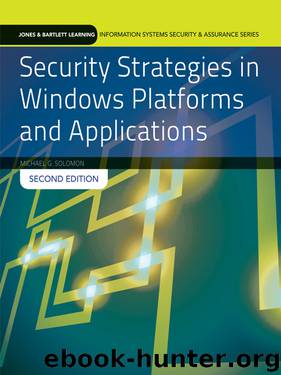Security Strategies in Windows Platforms and Applications by Solomon Michael G.;

Author:Solomon, Michael G.; [Solomon, Michael G.;]
Language: eng
Format: epub
Publisher: Jones & Bartlett Learning, LLC
Published: 2013-01-22T06:00:00+00:00
Windows defines rights and permissions based on user accounts. Windows runs every program as a specific user. That means even services run as a user. By default, many services run as a local admin account. If an attacker can exploit a vulnerability and compromise a service, it is possible the attacker could assume the identity of the user running the service. For this reason, it is important to run each service as a user that possesses the minimum privileges necessary to perform the service’s functions.
FYI
Windows Server 2008 R2 included the new managed service accounts (MSA) feature. While this made managing service accounts easier, it didn’t solve all of the issues. MSAs did provide automatic password management and instance name registration. However, the accounts could not be shared across multiple servers. Windows Server 2012 introduced group managed service accounts (gMSA). These accounts extend the earlier capabilities. Windows Server 2012 computers can share gMSAs and even use them for scheduled tasks. Administrators can also use the new gMSAs for more common software services, such as Microsoft Exchange or Microsoft SQL Server.
Download
This site does not store any files on its server. We only index and link to content provided by other sites. Please contact the content providers to delete copyright contents if any and email us, we'll remove relevant links or contents immediately.
Sass and Compass in Action by Wynn Netherland Nathan Weizenbaum Chris Eppstein Brandon Mathis(7966)
Grails in Action by Glen Smith Peter Ledbrook(7940)
Configuring Windows Server Hybrid Advanced Services Exam Ref AZ-801 by Chris Gill(7334)
Azure Containers Explained by Wesley Haakman & Richard Hooper(7318)
Running Windows Containers on AWS by Marcio Morales(6865)
Kotlin in Action by Dmitry Jemerov(5367)
Microsoft 365 Identity and Services Exam Guide MS-100 by Aaron Guilmette(5339)
Microsoft Cybersecurity Architect Exam Ref SC-100 by Dwayne Natwick(5099)
Combating Crime on the Dark Web by Nearchos Nearchou(4913)
The Ruby Workshop by Akshat Paul Peter Philips Dániel Szabó and Cheyne Wallace(4607)
Management Strategies for the Cloud Revolution: How Cloud Computing Is Transforming Business and Why You Can't Afford to Be Left Behind by Charles Babcock(4510)
The Age of Surveillance Capitalism by Shoshana Zuboff(4192)
Python for Security and Networking - Third Edition by José Manuel Ortega(4175)
Learn Wireshark by Lisa Bock(4015)
The Ultimate Docker Container Book by Schenker Gabriel N.;(3830)
Learn Windows PowerShell in a Month of Lunches by Don Jones(3587)
DevSecOps in Practice with VMware Tanzu by Parth Pandit & Robert Hardt(3503)
Windows Ransomware Detection and Protection by Marius Sandbu(3492)
Blockchain Basics by Daniel Drescher(3474)
